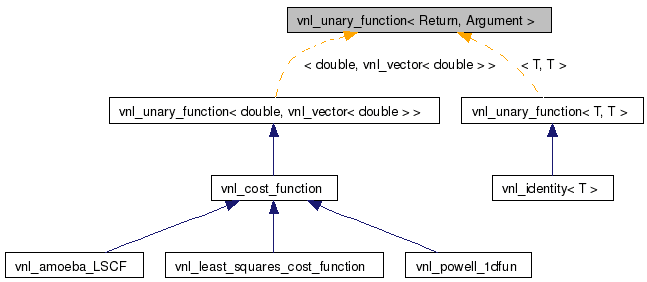Abstract 1D map between two types (read spaces). More...
#include <vnl_unary_function.h>

Public Member Functions | |
| virtual Return | f (Argument const &i)=0 |
| Apply the function. | |
| virtual Return | get_range_min () const |
| Return bounding cube of range (outputs). | |
| virtual Return | get_range_max () const |
| Return bounding cube of range (outputs). | |
| virtual vnl_unary_function < Return, Argument > * | Copy () const |
| Copy should allocate a copy of this on the heap and return it. | |
| virtual | ~vnl_unary_function () |
Detailed Description
template<class Return, class Argument>
class vnl_unary_function< Return, Argument >
Abstract 1D map between two types (read spaces).
Definition at line 29 of file vnl_unary_function.h.
Constructor & Destructor Documentation
| virtual vnl_unary_function< Return, Argument >::~vnl_unary_function | ( | ) | [inline, virtual] |
Definition at line 48 of file vnl_unary_function.h.
Member Function Documentation
| virtual vnl_unary_function<Return, Argument>* vnl_unary_function< Return, Argument >::Copy | ( | ) | const [inline, virtual] |
Copy should allocate a copy of this on the heap and return it.
If Subclasses do not implement this function, it will return null, but many applications will never call it, so this may not be a problem for you.
Reimplemented in vnl_identity< T >.
Definition at line 46 of file vnl_unary_function.h.
| virtual Return vnl_unary_function< Return, Argument >::f | ( | Argument const & | i | ) | [pure virtual] |
Apply the function.
The name is "f" rather than operator(), as the function will generally be called through a pointer. Note that the function is NOT const when you subclass.
Implemented in vnl_amoeba_LSCF, vnl_powell_1dfun, vnl_cost_function, vnl_identity< T >, and vnl_least_squares_cost_function.
| RETURN vnl_unary_function< RETURN, ARGUMENT >::get_range_max | ( | ) | const [virtual] |
Return bounding cube of range (outputs).
Definition at line 33 of file vnl_unary_function.txx.
| RETURN vnl_unary_function< RETURN, ARGUMENT >::get_range_min | ( | ) | const [virtual] |
Return bounding cube of range (outputs).
Definition at line 26 of file vnl_unary_function.txx.
The documentation for this class was generated from the following files:
- core/vnl/vnl_unary_function.h
- core/vnl/vnl_unary_function.txx
 1.7.5.1
1.7.5.1